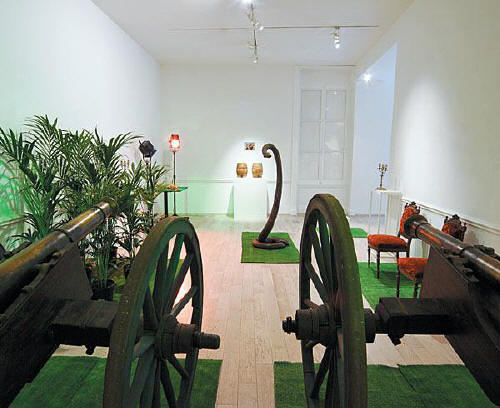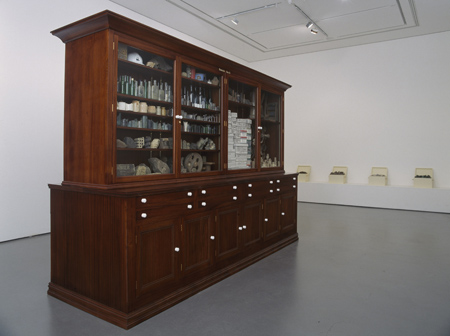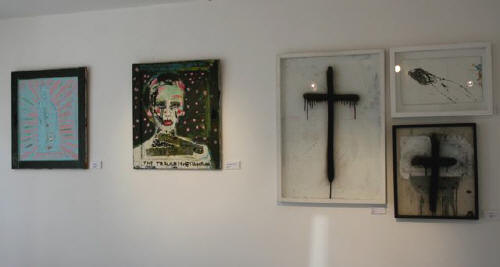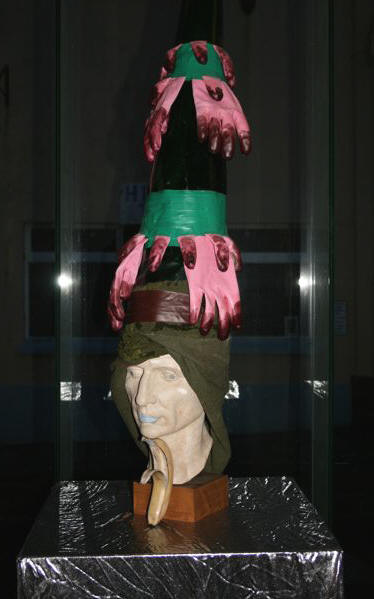|
|
| home | features | exhibitions | interviews | profiles | webprojects | gazetteer | links | archive | forum |
|
Art, objects and ‘superabundance’ Delpha Hudson
As we open our piles of Christmas presents, there is no better time to wonder at the meaning of the objects in our lives. And as we go into the next decade, how will we interpret the everyday 'things' that surround us? Contemporary art echoes life as the term ‘superabundance’ is batted around - and ‘superabundance’ is a very fitting word to describe our possessions in the West. Possessions test our value decisions about what really matters, and what 'things' really mean.
Discarded idiosyncratic, worn, and memory laden - everyday and historical objects are social and cultural artefacts. Artists have been quick to see not only powerful personal symbolism, but also institutional and cultural critique in their use. Broodthaer’s conceptual museum Department of Eagles (picture above right), set up in Brussels in 1968, played with the classification and categorisation of objects, questioning power structures and history. The Tate Britain’s recent show Classified dealt with similar themes: ‘How we see the world is how we understand it. Things are seen in relationship to other things and actions. Connections are made, naming takes place and meaning is formulated'. Yet rather than suggesting that objects can be understood according to an order imposed: ‘the meanings and names given to things are not fixed, but instead fluid.’ A projected joint 'object project' between the British Museum and the BBC was recently announced as an ‘unprecedented partnership’ in the national press (Guardian, 26th Nov 2009). This grand collaboration intends to construct a history of the world using objects collected from 2 million years of history. Curators working in new ‘connected’ ways intend to ‘assemble order, and meaning through ‘core objects’ and present them to diverse audiences in order to understand history’. Everyday and historical objects are used as symbols to create order and meaning, yet because classification strategies change throughout history, the way that they can be interpreted is never really fixed. Neither is meaning.
Mark Dion’s Tate Thames Dig 1999, in the Classified show (picture left), grouped together objects found on the banks of the River Thames. Displayed in a nineteenth century display cabinet none of the objects were labelled. Visitors were invited to form their own ideas about them. Here art invites imagined meaning rather than imposing order. Research reveals how objects are part of the process by which we become human. ‘Past memories, present experiences, and future dreams of each person are inextricably linked to the objects that comprise his or her environment’ (Csikszentmihalyi, 1981) It is as if objects are an expanded boundary of the self. We recognise ourselves in them. They are attached to time, place, and usage, and they have the potential to evoke narrative. This was the primary idea of Penzance’s Penlee Museum’s Object Project, a collaborative project by Sally Crabtree. Collecting diverse objects and stories, through a series of workshops, and placing it into a Cabinet of Curiosities, storytelling and humour was used to fuse fragments and diverse elements. Described as imaginative aesthetic experience, ‘the flux of life’ (Herwitz, 2008), seems a perfect way to describe how objects bring us to life, just as we have given them life.
Like chosisme (the writing of stories through ‘things’ not people) art’s fascination is often with objects’ bewildering power to haunt, and tell stories. The 2009 V&A show Telling Tales, showed contemporary designers rooting through stories and myths, to engender meaning, and imagination. It is as if ‘the synthesis of reality and imagination is one great symbolic narrative’ (Coupe, L, 1997, p.41) Joshua Sofaer’s project Object Retrieval, (also 2009), focused on only one object from UCL’s Museums & Collections. In the space of 7 days, the public were invited to join a rolling team of researchers from the arts and sciences ‘to stand outside of their own personal and professional bounds and take a fresh look at something they thought they already knew about.’ Art projects of this kind encourage our ability to re-visit meaning, and ask visitors to use their imaginations in interpreting objects. It is almost impossible nowadays to visit a museum, and look into a cabinet or display without some kind of art project insertion! Whilst this could become tiresome, revealing the public’s as well as the experts’ interpretive processes have seemingly become essential, as art created from objects invites permeable interpretations. As Octavio Paz says
Objects bring their own language, histories, and indeterminate meanings evoking reality, and stimulating the imagination. Art is the everyday object transformed, re-ordered and re-presented. St Ives Orchard gallery’s Christmas exhibition (picture above right), featured a selection of work from artists who assemble and paint objects. Debbie and Sam Hall developed a very particular aesthetic in curating this contemporary show. With edgy symbolism, and dark storytelling, objects here became vehicles for a kind of nightmare before Christmas. A similar haunting atmosphere was also to be found in Harriet Bell’s The Kellys and the O'Kellys there, at the The Millennium Gallery round the corner. It remains to be seen whether the meaninglessness, and meaning of historical and everyday objects, will continue to fire our imaginations, and untie the knot between order and interpretation but the next decade will undoubtedly continue to feature art shows that re-cycle objects, and re-cycle meaning.
Delpha Hudson, is part of a collaboration with Jesse Leroy-Smith, Chris Priest, Sam Bassett, and Richard Ballinger showing Possessed Possessions, at the Exchange Gallery, from Thursday 14th January 2010 (picture detail above left). This includes Silver Screen Séance 7-9pm Saturday 23rd January, featuring performance poets, art tarts and The Objects playing live. http://possessedpossessions.blogspot.com/ 29/12/09
References: Bourriard, N., (2009), Altermodern , Tate Publishing Coupe, L, (1997) Myth, Routledge:London Csikszentmihalyi, M & Halton, E(1981) The Meaning of Things, Cambridge University Press Herwitz, 2008) Aesthetics, Routledge:London Paz, O., (1987), Convergences, essays on art & Literature, Harcourt Brace Jovanovitch Inc. Ricoeur, (1974), The conflict of Interpretations, ed. D. Ighe, Evanston:Northern University press Virginia Wolff’s story Solid Objects, www.socialfiction.org/solidobjects.html, (23/09/2009) Classified show,www.tate.org.uk/servlet/CollectionDisplays?venueid=1&showid=2499, 22/12/09) Object retrieval project,www.objectretrieval.com/ (23/12/09) |
|
|




 ‘the
work of art is a secret sign exchanged between meaning and
meaninglessness’, (Paz, O., 1987, p. 54)
‘the
work of art is a secret sign exchanged between meaning and
meaninglessness’, (Paz, O., 1987, p. 54)